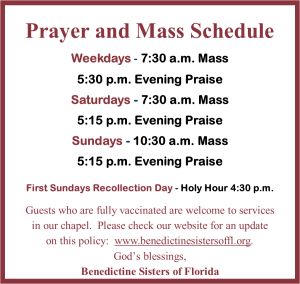Divine Mercy Sunday (April 28, 2019)
This past weekend we celebrated Divine Mercy Sunday. That raises a question: How can we learn mercy if we never see mercy in action? That thought alone should be an impetus to model a spirit of mercy in all our interactions. Mercy isn’t weakness – it takes patience, insight, control of your tongue, a peaceful spirit to be merciful.
 The celebration of Divine Mercy Sunday is a relatively new addition to our church calendar. It was first promulgated by Pope John Paul II in 2000, the day that he canonized Saint Faustina. Christ appeared to a Polish nun, Sister Maria Faustina Kowalska, in a series of visions that took place over almost eight years. In one of the visions, Christ asked Sister Faustina to pray for nine days, beginning on Good Friday and ending on the Saturday after Easter—the eve of the Octave of Easter. Thus, since the 9 days of a novena are commonly prayed in advance of a feast, the Feast of Divine Mercy—Divine Mercy Sunday—was born to be celebrated at the close of Easter Week.
The celebration of Divine Mercy Sunday is a relatively new addition to our church calendar. It was first promulgated by Pope John Paul II in 2000, the day that he canonized Saint Faustina. Christ appeared to a Polish nun, Sister Maria Faustina Kowalska, in a series of visions that took place over almost eight years. In one of the visions, Christ asked Sister Faustina to pray for nine days, beginning on Good Friday and ending on the Saturday after Easter—the eve of the Octave of Easter. Thus, since the 9 days of a novena are commonly prayed in advance of a feast, the Feast of Divine Mercy—Divine Mercy Sunday—was born to be celebrated at the close of Easter Week.
Sister Faustina is quoted from her diary: “Oh, if only all souls knew who is living in our churches?” This belief is a taste of what Thomas experienced when, in his presence, Jesus appeared the second time to his disciples. Thomas was invited to “touch and believe.” He recognized Jesus, his doubt was vanquished, and he professed his belief in Christ. “My Lord and my God.”
Do we recognize the Christ among us? When the Eucharistic minister looks you in the eye and greets you: “Body of Christ. Blood of Christ” is our AMEN simply a rote, expected response? What about when you are the Eucharistic minister? Does your greeting to the communicant, “Body of Christ” convey your belief that, “Yes, THIS is the Body of Christ.” But more than that, YOU are the Body of Christ; I am the Body of Christ? Does our AMEN to the greeting signify a true conviction that “yes, you and I are Christ for each other?” If we cannot greet Christ in each other, how will we recognize Jesus at the pearly gates?
Thankfully, there is a trend today among media services to make an effort to balance stories of horror and tragedy with illustrations of mercy. For many people there are two stories that continue to stand out – the story of the Amish community that walked to the home of the man who had killed 5 (five) of their children to tell his widow they forgave her husband for what he had done, and they consoled her for the loss of her spouse. They buried their anger before they buried their children. Today on the wall of the community firehouse is a watercolor of the schoolyard painted by a local artist. Its title is “Happier Days,” and it depicts the Amish children playing without a care before the shooting. Five birds, which some say represent the dead girls, circle the blue sky above.
 The other well-known story of forgiveness, you may recall, was depicted on the cover of TIME magazine 1984. It pictured a prison cell where two men sat on metal folding chairs. The young man wore a black turtleneck sweater, blue jeans and white running shoes. The older man was dressed in a white robe and had a white skullcap on his head. They sat facing one another, up close and personal. They spoke quietly to keep others from hearing the conversation. The young man was Ali, an attempted assassin; the older man was Pope John Paul II, his intended victim. The pope held the hand that had held the gun whose bullet had torn into his body. At the end of their 20-minute meeting, Ali raised the pope’s hand to his forehead as a sign of respect. John Paul shook Ali’s hand tenderly.
The other well-known story of forgiveness, you may recall, was depicted on the cover of TIME magazine 1984. It pictured a prison cell where two men sat on metal folding chairs. The young man wore a black turtleneck sweater, blue jeans and white running shoes. The older man was dressed in a white robe and had a white skullcap on his head. They sat facing one another, up close and personal. They spoke quietly to keep others from hearing the conversation. The young man was Ali, an attempted assassin; the older man was Pope John Paul II, his intended victim. The pope held the hand that had held the gun whose bullet had torn into his body. At the end of their 20-minute meeting, Ali raised the pope’s hand to his forehead as a sign of respect. John Paul shook Ali’s hand tenderly.
In the cell, unseen in the picture, were the pope’s secretary and two security agents, along with a still photographer and video camera man. John Paul wanted this scene to be shown around a world filled with nuclear arsenals and unforgiving hatreds. When the pope left the cell he said, “What we talked about must remain a secret between us. I spoke to him as a brother whom I have pardoned and who has my complete trust.” John Paul’s deed with Ali spoke a thousand words. The scene of John Paul and Ali has become an icon of living mercy.
John Paul II and the Amish Christians teach us that forgiveness is central and that God depends on us to extend forgiveness to other people. That’s what the mercy of God is all about. Take some time this week to recall when God’s mercy has come to you through the graciousness of another. How are you being called to share God’s mercy?
~Reflection by Sister Roberta Bailey, OSB, Prioress
Have a good week!
May 3 we, the Benedictine Sisters of Florida, mark Employee Appreciation Day, employees are invited to a luncheon in their honor and then have the rest of the day (paid) off… that means the cooks goes home too… But we also have a tradition now for about 7 years… a handful of volunteers take over the kitchen and provide an evening meal of a fish dinner with all the trimmings… always a good time.
And this year we have a newly screened-in porch off the dining room to “spill out” into… mosquito-free… The screen project was funded through an inheritance we received from a lady who had included us in her estate planning … God bless her and may she rest in peace… imagining her looking down I can hear her saying: “it’s about time!” Sister Roberta


Leave a Reply